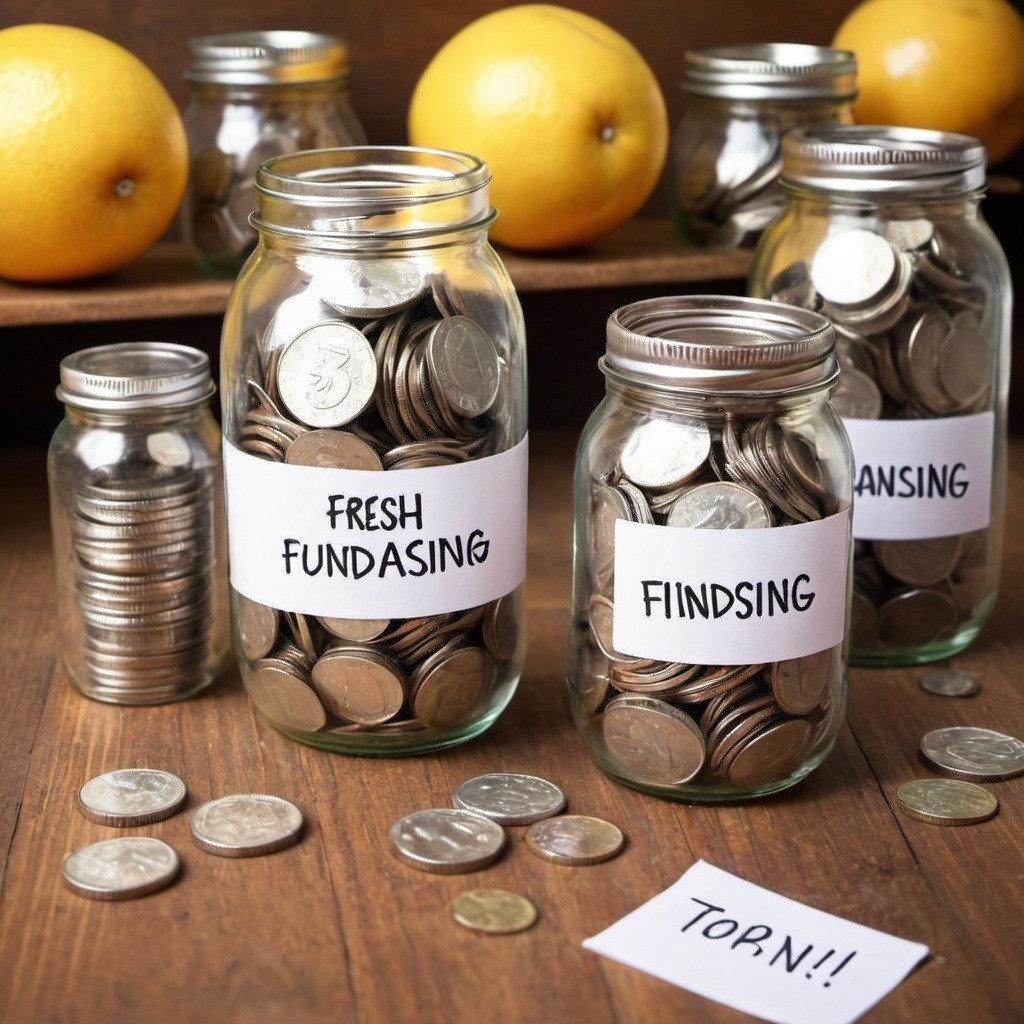
Introduction: The Importance of Fresh Fundraising Ideas
In today’s fast-paced world, the landscape of fundraising is continuously evolving. Traditional methods like bake sales and car washes, while still effective, are no longer enough to capture the attention of potential donors. The rise of digital platforms and the increasing competition for donor dollars mean that organizations need to think creatively and innovatively to stand out.
The importance of fresh fundraising ideas cannot be overstated. Whether it’s incorporating technology, leveraging social media, or hosting unique events, creativity can be the key to engaging supporters and reaching fundraising goals. By embracing new strategies, organizations can connect with a broader audience, create memorable experiences, and ultimately, make a more significant impact.
For those looking to explore modern fundraising strategies, resources like TechSoup’s guide on digital fundraising or Classy’s blog on creative fundraising ideas offer excellent insights.
Virtual Fundraising Events: Going Beyond Zoom
In the age of digital connection, virtual fundraising events have become a popular and effective way to engage supporters. However, to truly stand out, it’s essential to think beyond the usual Zoom calls and webinars. The key to a successful virtual fundraiser is creating an interactive and engaging experience that makes participants feel connected to your cause.
One idea is to host a virtual cooking class where participants can learn a new recipe from a professional chef while supporting your organization. This not only provides entertainment but also gives attendees something tangible to take away. Similarly, live-streamed concerts featuring local artists or well-known musicians can draw in a diverse crowd and provide a memorable experience that people will want to share.
Another creative approach is to organize online auctions. By offering unique items or experiences, you can attract a wider audience and drive competitive bidding, all from the comfort of participants’ homes. Platforms like Givebutter’s guide on virtual events and Charity Auctions Today provide excellent resources to help you plan and execute these events seamlessly.
Crowdfunding Campaigns: How to Stand Out
Crowdfunding has become a go-to method for many organizations looking to raise funds quickly and effectively. However, with so many campaigns vying for attention, it’s essential to craft a compelling narrative that resonates with potential donors. The key to a successful crowdfunding campaign lies in storytelling. Your campaign should clearly communicate the impact of the funds raised, showing exactly how donations will make a difference. This not only builds trust but also motivates people to contribute.
When crafting your campaign, focus on creating a powerful visual and emotional appeal. Use engaging videos and images to tell your story and highlight the urgency of your cause. Personal testimonials from those who have benefited from your organization’s work can also add a personal touch that resonates with potential donors.
Choosing the right platform is also crucial to your campaign’s success. Sites like GoFundMe and Kickstarter are popular choices, but niche platforms like Mightycause or Fundly might offer more tailored features for nonprofits. For inspiration, look at successful campaigns on these platforms to see what strategies they employed. By analyzing what works, you can adapt those elements to your own campaign, increasing your chances of success.
Peer-to-Peer Fundraising: Empower Your Supporters
Peer-to-peer fundraising is a powerful way to extend your reach by turning your supporters into advocates for your cause. This approach not only amplifies your message but also empowers your supporters to take an active role in your fundraising efforts. By encouraging them to create personal fundraising campaigns, you can tap into their networks, reaching potential donors you might not have otherwise connected with.
To get started, provide your supporters with the tools and resources they need to succeed. This includes easy-to-use fundraising platforms, like Classy or GoFundMe Charity, where they can set up their campaigns. Offering templates for emails, social media posts, and personalized fundraising pages can also make the process smoother and more effective.
Success stories in peer-to-peer fundraising often come from campaigns that are deeply personal. For example, a supporter who has a close connection to your cause may share their personal story, creating an emotional appeal that resonates with their friends and family.
Campaigns like these often see a higher level of engagement and donations.
Best practices for peer-to-peer fundraising include setting clear goals, offering incentives for top fundraisers, and providing ongoing support and encouragement. Regular updates on the campaign’s progress and celebrating milestones can keep momentum going and make your supporters feel valued and motivated. For more tips and examples, resources like DonorDrive’s guide on peer-to-peer fundraising can be incredibly helpful.
Hybrid Events: Combining In-Person and Virtual Efforts

Hybrid events are a dynamic way to blend the best of both worlds—combining the energy of in-person gatherings with the expansive reach of virtual participation. Planning and executing a successful hybrid event requires careful consideration of how to engage both audiences effectively. This fundraising idea allows you to give your supporters the flexibility to choose how they want to participate, whether they prefer to join in person or from the comfort of their own homes.
To start, ensure that your event is accessible and engaging for both in-person and virtual attendees. This might involve setting up live-streaming capabilities for key moments, such as guest speakers or live auctions, while also organizing interactive online activities for those joining remotely. Consider using a platform like Zoom Events or Hopin to manage the virtual side of your hybrid event seamlessly.
Maximizing participation through both mediums can be achieved by offering unique incentives. For example, consider giving extra gifts or exclusive content to those who donate a certain amount, whether they’re attending in person or virtually. This could include a special thank-you gift, access to a VIP online session, or even a shoutout during the event.
Schools can also benefit greatly from hybrid events as a school fundraising idea. Hosting a hybrid fun run or talent show allows students and parents to participate no matter where they are. By offering both in-person activities and online streaming, you can increase the overall reach and total amount raised, making it easier for everyone to get involved and contribute.
To ensure your hybrid event is a success, focus on clear communication with your audience, robust technical support, and a well-thought-out schedule that keeps both in-person and virtual participants engaged throughout the day. Resources like Qgiv’s guide on hybrid events can offer additional insights and tips to help you navigate this growing trend in fundraising.
Subscription-Based Fundraising: A New Monthly Approach
Subscription-based fundraising is an innovative strategy that provides a steady and reliable stream of income by encouraging supporters to commit to a regular, ongoing contribution. This approach not only helps with long-term planning but also builds a stronger relationship with donors who feel more connected to your cause.
To create a successful subscription model, start by offering a monthly giving program where supporters can pledge a specific amount each month. This could be as simple as a recurring donation or something more structured, like a “membership” that comes with added perks. For example, donors who commit to a monthly gift could receive a special thank-you package, early access to events, or personalized updates about how their contributions are making a difference.
Another idea is to offer exclusive content access as part of your subscription model. This could include behind-the-scenes videos, interviews with key figures in your organization, or even a private newsletter with stories and updates that aren’t shared publicly. By providing this kind of unique content, you give subscribers something valuable in return for their ongoing support, making them feel like a vital part of your community.
An excellent example of this approach in action is Patreon, a platform where creators can offer exclusive content to their subscribers in exchange for monthly payments. Nonprofits can adapt this model by offering similar benefits tailored to their supporters’ interests.
To make your subscription-based fundraising more attractive, consider creating different levels of giving, where higher contributions unlock additional perks or gifts. This tiered approach can encourage donors to give a bit more each month in exchange for added value.
If you’re looking for inspiration and practical guidance, check out resources like Classy’s guide on monthly giving and Network for Good’s tips on donor retention. These can help you design a compelling and sustainable subscription model that keeps supporters engaged and your fundraising efforts consistent.
Unique Raffle and Auction Ideas: Standing Out from the Crowd
Raffles and auctions are time-tested fundraising strategies, but to truly stand out from the crowd, it’s essential to offer creative and unique items or experiences that will captivate your audience. Whether you’re planning an event for your school, a community group, or a nonprofit, adding a twist to these classic fundraising methods can significantly boost participation and funds raised.
One way to make your raffle or auction memorable is by offering one-of-a-kind experiences that people can’t easily buy. For instance, you could auction off a day with a local celebrity, a behind-the-scenes tour of a popular venue, or even a personalized experience like a private cooking class with a renowned chef. These experiences are not only unique but also create lasting memories for the winners, making them more likely to bid higher.
For school fundraising ideas, consider offering items that resonate with your community, such as VIP parking spots for high school events, the opportunity for a student to be “Principal for a Day,” or a custom mural painted by an art teacher and students. These prizes can create a strong emotional connection, encouraging parents and community members to participate enthusiastically.
To maximize the reach and success of your raffle or auction, leveraging online platforms is key. Online fundraising platforms like OneCause or BiddingForGood make it easy to host virtual auctions and raffles, allowing you to reach a broader audience beyond just those who can attend in person. This is especially beneficial for high school events or school fundraisers where alumni and extended family members might want to participate from afar.
Incorporating online fundraising into your strategy also enables you to promote the event widely through social media and email campaigns, ensuring that more people are aware of the unique opportunities you’re offering. Additionally, by using these platforms, you can extend the bidding time and even allow winners to receive their items or experiences digitally, making the process seamless and efficient.
If you’re looking for more inspiration and guidance, resources like Qgiv’s auction ideas or Fundraising.com’s raffle tips can help you brainstorm unique items and optimize your online presence to ensure your event is a standout success.
Merchandise Fundraising: Branded Products That Sell

Merchandise fundraising is an excellent way to raise money while spreading awareness about your cause. By creating custom products that align with your mission, you can offer supporters something tangible in return for their contributions. The key to successful merchandise fundraising lies in designing products that resonate with your audience and effectively promote your organization.
Start by brainstorming custom merchandise ideas that are closely tied to your cause. For instance, if you’re raising funds for environmental conservation, you might sell reusable water bottles, eco-friendly tote bags, or organic cotton T-shirts featuring your organization’s logo or a meaningful slogan. Schools can create branded apparel like hoodies or caps with the school’s name and mascot, making them popular items among students, parents, and alumni.
To ensure your merchandise stands out, focus on high-quality products that people will want to use or wear regularly. Consider limited edition items or unique designs that make your merchandise feel special. Partnering with local artists or designers to create these products can add an extra layer of appeal and give your supporters something truly unique.
Promoting and selling merchandise online is essential for reaching a broader audience. Utilize platforms like Bonfire or Teespring that specialize in custom merchandise and make it easy to set up an online store. These platforms handle everything from production to shipping, so you can focus on promoting your products.
To drive sales, integrate your merchandise into your overall fundraising campaign. Share stories or testimonials that highlight the impact of your cause and how purchasing your merchandise supports it. Use social media to showcase your products with high-quality photos and encourage your supporters to share pictures of themselves using or wearing your items.
Offering incentives like free shipping for a limited time or a discount on the next purchase can also boost sales.
Don’t forget to leverage email marketing as well. Send out regular updates featuring your latest merchandise and remind supporters how their purchases contribute to the greater good. By aligning your products with your cause and promoting them effectively online, you can turn merchandise fundraising into a powerful tool for both raising funds and building brand awareness.
Social Media Challenges: Engage and Expand Your Audience
Social media challenges have become a powerful tool for engaging audiences and driving fundraising efforts. By creating viral challenges that encourage participation, you can quickly expand your reach, increase awareness, and boost donations. The key to a successful social media challenge is to make it fun, shareable, and aligned with your cause.
Start by designing a viral social media challenge that resonates with your audience and is easy to participate in. For example, you could launch a hashtag campaign where participants post photos or videos of themselves completing a specific task related to your cause. Think of popular challenges like the ALS Ice Bucket Challenge, which went viral and raised millions by encouraging people to dump ice water over their heads and challenge friends to do the same while making a donation.
Another effective strategy is to create a donation challenge where participants are encouraged to donate a small amount and then challenge others to do the same. This type of challenge can quickly snowball, especially if you set a goal or create a sense of urgency. For instance, a “24-hour donation blitz” where participants challenge their friends and family to donate within a short time frame can lead to a surge in contributions.
To ensure your challenge gains traction, choose a catchy and memorable hashtag that participants can use to tag their posts. This makes it easy for others to find and join in on the fun. Promote the challenge across all your social media channels, and encourage your followers to share their participation with their networks. Collaborating with influencers or local celebrities can also amplify your reach and attract more participants.
For example, you might launch a campaign where people post a video of themselves performing a unique act of kindness with the hashtag #KindnessForACause, encouraging others to do the same and make a donation. Or, for school fundraising, you could start a challenge where students and teachers share their creative ways of raising funds using the hashtag #SchoolSpiritChallenge.
To maximize the impact, offer incentives for those who participate, such as featuring them on your social media pages or entering them into a raffle for a special prize. Regularly update your audience on the progress of the challenge, and celebrate milestones to keep the momentum going.
If you’re looking for ideas and best practices, resources like Hootsuite’s guide on creating viral challenges and Nonprofit Tech for Good’s article on social media campaigns can provide valuable insights on how to craft and promote a challenge that engages your audience and drives fundraising success.